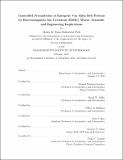| dc.contributor.advisor | Manuel Martinez-Sanchez. | en_US |
| dc.contributor.author | De Soria-Santacruz Pich, Maria | en_US |
| dc.contributor.other | Massachusetts Institute of Technology. Department of Aeronautics and Astronautics. | en_US |
| dc.date.accessioned | 2014-05-23T17:13:35Z | |
| dc.date.available | 2014-05-23T17:13:35Z | |
| dc.date.copyright | 2014 | en_US |
| dc.date.issued | 2014 | en_US |
| dc.identifier.uri | http://hdl.handle.net/1721.1/87127 | |
| dc.description | Thesis: Ph. D., Massachusetts Institute of Technology, Department of Aeronautics and Astronautics, 2014. | en_US |
| dc.description | This electronic version was submitted by the student author. The certified thesis is available in the Institute Archives and Special Collections. | en_US |
| dc.description | Cataloged from student-submitted PDF version of thesis. | en_US |
| dc.description | Includes bibliographical references (pages 235-247). | en_US |
| dc.description.abstract | The inner Van Allen radiation belt traps highly energetic protons sourced from solar storms, cosmic rays and other processes. These particles can rapidly damage the space systems orbiting the inner region, limiting access to Low Earth Orbit (LEO). Decades of modeling and observations, however, show that naturally generated ULF/VLF waves have the capability of precipitating energetic trapped electrons and protons. This fact suggests that there could be human control over the stable inner belt proton population by artificially transmitting Electromagnetic Ion Cyclotron (EMIC) waves from space-based antennas (named remediation). These waves are naturally generated by equatorial ring current ions in the outer belt region, which explains the absence of EMIC waves at lower altitudes. Consequently, the precipitation of high-energy protons requires artificial generation of EMIC waves into the inner zone. The controlled removal of energetic outer belt electrons by man-made whistler waves has been widely studied, and a space test of a linear antenna for this purpose is in preparation. Contrarily, the interaction between inner belt protons and EMIC waves from in-situ transmitters is an unexplored solution to the radiation environment that should be addressed given its relevance to the scientific and engineering communities. This dissertation focuses on four interconnected research efforts in this direction, which are (1) the radiation of EMIC waves from a space-based antenna, (2) the propagation of these waves in the inner radiation belt, (3) the wave-particle interactions with energetic trapped protons and (4) the feasibility of a mission capable of significantly reducing this hazardous radiation. Our analyses show that a DC rotating coil antenna would be capable of radiating EMIC waves into space. Magnetic dipoles, however, have a very small radiation resistance. Additionally, the interaction between these waves and energetic protons is very inefficient. Our simulations show that, with the current technology, it is not engineeringly feasible to clean up the proton belt using space-based transmitters. A mission scaled down to detectability of the precipitating protons, however, could be launched easily and would allow us to better understand the science and test the technology involved in the concept of remediation. | en_US |
| dc.description.statementofresponsibility | by Maria de Soria-Santacruz Pich. | en_US |
| dc.format.extent | 247 pages | en_US |
| dc.language.iso | eng | en_US |
| dc.publisher | Massachusetts Institute of Technology | en_US |
| dc.rights | M.I.T. theses are protected by copyright. They may be viewed from this source for any purpose, but reproduction or distribution in any format is prohibited without written permission. See provided URL for inquiries about permission. | en_US |
| dc.rights.uri | http://dspace.mit.edu/handle/1721.1/7582 | en_US |
| dc.subject | Aeronautics and Astronautics. | en_US |
| dc.title | Controlled precipitation of energetic Van Allen belt protons by electromagnetic ion cyclotron (EMIC) waves : scientific and engineering implications | en_US |
| dc.type | Thesis | en_US |
| dc.description.degree | Ph. D. | en_US |
| dc.contributor.department | Massachusetts Institute of Technology. Department of Aeronautics and Astronautics | |
| dc.identifier.oclc | 879663074 | en_US |
